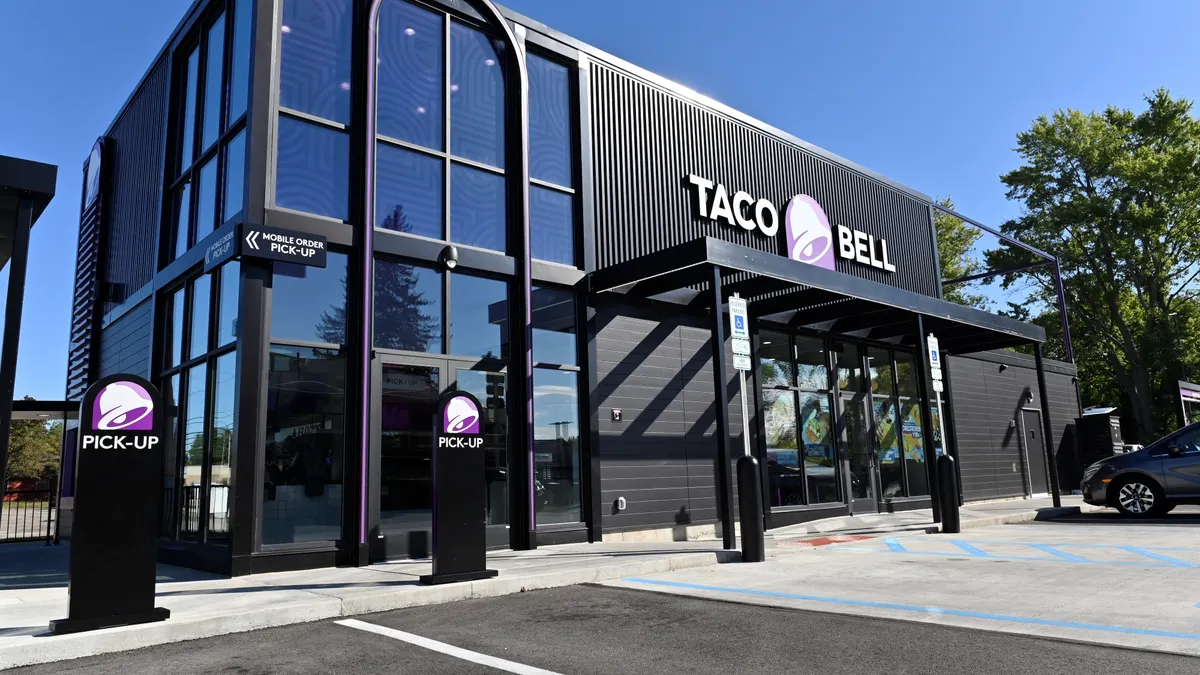UPDATE: 11/24/2025: This piece has been updated with the Bureau of Labor Statistics’ most recent jobs, wage and turnover data.
The restaurant labor market has cooled, statistics show, but gains in employment are continuing.
The post-COVID surge in hiring gave low-wage workers — like those in restaurants and hotels — more bargaining power at the individual level, said Elise Gould, a senior economist at the Economic Policy Institute in a 2023 interview. As a result, wages began to grow.
“Low-wage growth between 2019 and 2022 [was] much faster than any other business cycle that we've had in the U.S.,” Gould said. In a 2025 interview with Restaurant Dive, Gould said that in the first post-COVID years “you saw wages increasing 10% to 15% year over year.”
Ara Kharazian, a research and data lead for Square, said wage growth across geographical regions mean most restaurant workers now earn at least a couple dollars more than minimum wage.
“Even the 10th percentile of workers are making several dollars above the minimum wage,” Kharazian said.
In foodservice and hospitality, wage growth outpaced inflation in 2021 and 2022, a stark contrast to most industries, which saw wages lag behind increases in the consumer price index.
But as employment stabilized in 2023 and 2024, the pendulum swung back in favor of employers, to some degree, and wage growth moderated. There have been political changes too: In July 2025 Congress passed a major spending package backed by President Donald Trump, which included significant cuts to programs workers may rely on. Then in October, the federal government shut down as a result of legislative deadlock over healthcare subsidies. The impacts of the shutdown are not yet visible in employment data, though the political conflict delayed the release of the BLS’ October jobs report.
“Low wage workers — like many restaurant workers — who rely on public health insurance, may rely on other assistance programs, food assistance, that it's going to be much harder to come by,” Gould said.
Those cuts further weaken worker power. “It's a buyer's market for employers. They can just pay less than workers might have been able to demand otherwise,” Gould said.
“Nominal wage growth has been decelerating,” Gould told Restaurant Dive in an interview for a 2024 update to this article. Subsequent months of labor market data indicate that this is still true.
According to one working paper from the National Bureau of Economic Research, high turnover, low unemployment and a high number of job openings per applicant in low-wage sectors was significant enough to measurably decrease worker pay inequality through wage growth.
Gould said the first half of 2025 has been relatively static for the restaurant labor market.
“In general, the labor market looks a lot like it did last year in this sector,” Gould said. While economic uncertainty is weighing on restaurants, Gould said that it hasn’t yet produced significant shifts in key labor market dynamics.
But some changes, like tariffs or dramatic immigration raids, may not show up in macroeconomic data at scale.
“People may be worried to go to their jobs, even if they've been assured that they're not going to experience a raid, and people may be worried and so that will keep them from working, and that can make it difficult,” Gould said. “There could be huge macro ramifications beyond the harm to those workers and their families.”
Restaurant Dive has traced these labor trends in six graphs below, based on Bureau of Labor Statistics data. This data shows that sectoral employment has reached pre-pandemic levels and unemployment in the sector has increased since mid-2024, while hires, quits and total separations have fallen slowly since early 2023, and may have reached a rough equilibrium, despite some fluctuations.
Taken together, this data shows a clear loosening of the national restaurant labor market, indicating that workers are losing some power to demand high wages and exercise discretion in job choices.
These graphs will be updated monthly, and we will refresh our analysis to reflect changes in major labor market trends.
The restaurant unemployment rate has returned to pre-COVID-19 levels.
Unemployment in accommodation and food services peaked at about 35.4% in April 2020. It has since fallen, hovering between 5% and 6% for most of 2022 and 2023. Sectoral unemployment has increased since then, from a low of 4.7% in December 2023 to a high of 7.9% in February 2025. Subsequent months have seen unemployment range from a low of 5.5% in April, and to a high of 6.8% in August — with a slight decrease in September. The most recent unemployment numbers, however, are largely in line with last year’s levels, indicating that even if other sectors of the economy are seeing job losses — unemployment is up overall — conditions in foodservice have not changed much.
Still, sectoral unemployment may increase if layoffs in other sectors trigger an influx of job-seekers in the foodservice industry, a phenomenon that would reduce wage growth.
Weekly average hours have bounced back from mid-pandemic lows, but still trail normal seasonal levels.
The hours worked by restaurant workers have generally fallen year over year, while maintaining seasonality since July 2021, when average weekly hours peaked at 25.4 for production and nonsupervisory restaurant workers. The peak hours in 2022, 2023 and 2024 were each lower than the year before. This extended decline indicates part-time workers comprise a greater share of the workforce than in preceding years.
Despite a steep drop from December to January, hours worked in 2025 are, broadly, similar to 2024 numbers, with both years seeing hours worked peak in June at 24.1 hours per week. A stabilization of hours could indicate a stabilization in demand for part-time workers relative to full-time workers.
Gould emphasized that foodservice average hours are exceptionally low, when compared to other sectors.
“Their average hours are lower than [almost] any other industry,” Gould said. “It's always so striking as a phenomenon.
Real wage growth has slowed
Average hourly wages for production and nonsupervisory restaurant workers jumped from $13.36 in April 2020 to $19.43 in August 2025, a sustained nominal increase. But that increase obscures the impact of inflation on wages: Extending the timeframe back to 2018, which gives two control years, shows that inflation-adjusted wages have increased only modestly, from $12.78 in January 2018 to $14.87 in 2025.. While both nominal and inflation-adjusted wages are higher this year than last year, real wage growth was anemic in 2024. The uptick in December — which pushed inflation adjusted wages above $15 an hour compared to 2018 values for the first time — was likely due to demand for workers during the holiday season, and wages have since fallen slightly in adjusted terms.
While the restaurant industry is only one sector, weak earnings growth for low wage workers could help explain the persistently low same-store sales growth and falling traffic at many major brands.
“Low wage workers still have a really hard time making ends meet. It’s not like we've negated the fact that many workers just really suffer from very low wages,” Gould said. Many publicly traded restaurant brands have specifically remarked that price sensitivity is worst among low-income consumers, a group that likely overlaps significantly with low-wage workers
Total employment in restaurants has reached pre-COVID-19 levels.
The number of restaurant workers stabilized around 12.2 million in Q2 2023, ending a run of dramatic growth that began in December 2020. Employment reached pre-pandemic levels in August 2023, with 12.2 million workers in the sector and held relatively steady for nearly a year. This steadiness has been the defining characteristic of restaurant employment numbers in the last two years.
Steady total employment in the sector is not, however, necessarily a positive indicator. The restaurant sector saw consistent growth in employment between the end of the Great Recession and the onset of COVID-19, as the industry itself grew. Steady employment may mean the sector is in a sort of stasis — no surprise given consumer price sensitivity, high input costs and economic uncertainty exacerbated by tariffs.
Since January of this year the industry has added about 90,000 jobs — below the roughly 150,000 it added in 2024 — and the latest jobs numbers are preliminary figures, meaning talk of an employment surge in restaurants is premature.
How many workers are leaving their jobs?
What percentage of workers are leaving their jobs?
Shown here both in absolute numbers and in percentages of the restaurant workforce, key indicators of labor turnover, quits and total separations generally fell from 2023 to the start of 2025, and have since sped up again, with occasional fluctuations. Job openings have generally outpaced hiring over the last year. The number of quits fell by about a third between August 2022 and December 2024, but rebounded significantly over the spring, reaching 752,000 in June 2025, the highest level since February 2023 — the number and rate of quits has since fallen significantly, as have hires and total separations. Job openings, however, are up.
When combined with flat real wage growth, the slowing turnover in 2024 was a sign that conditions in the restaurant labor market were shifting back in the favor of employers. These factors, combined with the continued high unemployment in the sector and the low average weekly hours indicate that the shift in power towards employers has continued this year. The decline in quits in recent months may reflect a negative macroeconomic outlook on the part of low-wage workers.
“One key way to raise your wages [has been] to leave your current job,” Gould said. “Now, since that trend has slowed down, you no longer have that sort of primary way to get wage increases by leaving your job and taking another one. I’m not surprised that we’re seeing that slow down as well.”













